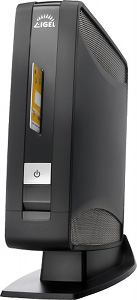Thin client gets Nano upgrade, uses less power
Oct 4, 2011 — by LinuxDevices Staff — from the LinuxDevices Archive — viewsIgel announced that its UD5 thin client now comes with a 1.3GHz Via Nano processor, DDR3 memory, and the VX900 chipset. Now 40 percent faster than before, the device also has lower power consumption and is newly offered with the Windows Embedded Standard 7 operating system, the company says.
In January 2009, Igel faced us with five new thin clients — the UD2, UD3, UD5, UD7, and UD9 — that came in four different form factors, with a choice of Via Eden, Via C7, or AMD Sempron processors. Among the first to run the Windows Embedded Standard 2009 operating system, these devices were offered with software bundled in three different "Digital Service Packs,"
 Mercifully for our fingers, the Bremen, Germany-based company's Oct. 4 announcement concerned only one product, a revised version of the UD5 (pictured). The device still measures 10.7 x 9.64 x 4.09 inches, with an externally accessible PCI expansion slot, but its internals have been upgraded, Igel says.
Mercifully for our fingers, the Bremen, Germany-based company's Oct. 4 announcement concerned only one product, a revised version of the UD5 (pictured). The device still measures 10.7 x 9.64 x 4.09 inches, with an externally accessible PCI expansion slot, but its internals have been upgraded, Igel says.
Previously, the UD5 employed a 1.5GHz Via C7 processor, along with the chipmaker's CN896 companion chip. Still Via-based, it now gets a 1.3GHz Nano processor and the VX900 northbridge/southbridge, the latter providing HD video playback.
According to Igel, the new chips give the revised UD5 40 percent faster performance, as well as significantly lower power consumption. Previously, the thin client was said to use 18 Watts while idling, and four Watts while sleeping; now, it uses 11 Watts while idling, and just one Watt while sleeping, the company says.
Formerly starting with 512GB of RAM, the UD5 is now supplied with 2GB of RAM in its Windows Embedded Standard 7 configuration, or 1GB apiece in the Windows Embedded Standard 2009 and Linux versions that remain available. Flash storage is 4GB for WES 7, 2GB for WES 2009, and 1GB for Linux.
Igel says the UD5 has a Display Port video output, that, presumably with a cable adaptor, can support dual screens (1920 x 1200 pixels each). As before, it has six USB 2.0 ports (two in front, four in the rear), a gigabit Ethernet port, line out and mic in audio connectors, a PS/2 port, and two serial ports.
Two different "connectivity feet" are offered as accessories. One of them has a parallel port and an "anti-theft" USB port, while the other has a parallel port and 802.11b/g wireless networking, according to Igel. The device is also available with an optional smart card reader (pictured earlier in our story), for two-factor authentication and single sign-on, the company adds.
Specifications listed by Igel for its revised UD5 include:
- Processor — Via Nano clocked at 1.3GHz
- Chipset — Via VX900
- Memory — 1G or 2GB of RAM
- Storage — 1GB (Linux), 1GB (WES 2009), 2GB (WES 7)
- Expansion — PCI slot
- Networking — gigabit Ethernet; wireless networking via optional connectivity foot
- Other I/O:
- Display Port
- audio — line out, mic in
- 1 x PS/2
- 2 x serial
- 6 x USB 2.0 (2 front, 4 rear); optional anti-theft USB port via connectivity foot
- parallel port (optional on connectivity foot)
- Power — external 100~240VAC adapter; 11W idle consumption, 1W sleep
- Operating range — 32 to 104 deg. F
- Dimensions — 0.7 x 9.64 x 4.09 inches
- Weight — 4.71 pounds
Further information
U.S. pricing was not announced, but Igel says the UD5 is available now. U.K. prices are said to range from 341 U.K. pounds (about $528) for a model with Linux and "entry" firmware to 445 U.K. pounds (about $688) for a model with Windows Embedded Standard 7 and "advanced" firmware.
More information may be found on the UD5 product page.
Jonathan Angel can be reached at [email protected] and followed at www.twitter.com/gadgetsense.
This article was originally published on LinuxDevices.com and has been donated to the open source community by QuinStreet Inc. Please visit LinuxToday.com for up-to-date news and articles about Linux and open source.